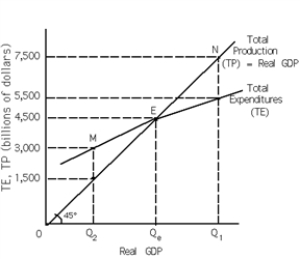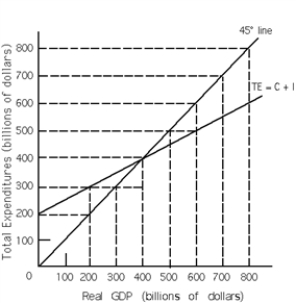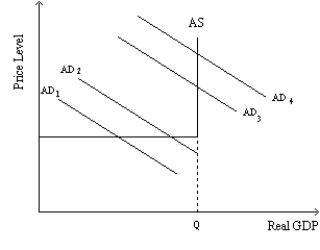A) downward; rise; decrease; falls; $7.5 billion
B) downward; fall; increase; rises; $40 billion
C) downward; rise; decrease; falls; $40 billion
D) upward; rise; decrease; falls; $40 billion
E) downward; fall; decrease; falls; $7.5 billion
Correct Answer

verified
Correct Answer
verified
Multiple Choice
 -Refer to Exhibit 10-8.The consumption function is
-Refer to Exhibit 10-8.The consumption function is
A) C = 0.80(Yd) .
B) C = $4,000 + 0.90(Yd) .
C) C = $400 + 0.2(Yd) .
D) C = $400 + 0.8(Yd) .
Correct Answer

verified
Correct Answer
verified
True/False
Classical economists and Keynes shared the belief that increased saving would necessarily stimulate an equal amount of increased investment spending.
Correct Answer

verified
Correct Answer
verified
Multiple Choice
The economy is in equilibrium,TP = TE,and Real GDP is $4,000 billion.The MPC is 0.70,the multiplier is operative,and idle resources exist at each expenditure round.Government purchases fall by $17 billion.As a result,the TE curve shifts __________,inventory levels unexpectedly __________,business firms __________ the quantity of goods and services they produce,and Real GDP __________ by __________.
A) downward; rise; decrease; falls; approximately $56.7 billion
B) downward; fall; increase; falls; approximately $56.7 billion
C) upward; rise; decrease; falls; $17 billion
D) upward; fall; decrease; rises; $17 billion
E) downward; rise; decrease; falls; approximately $11.9 billion
Correct Answer

verified
Correct Answer
verified
Multiple Choice
 -Refer to Exhibit 10-8.The multiplier is
-Refer to Exhibit 10-8.The multiplier is
A) 0.20.
B) 4.
C) 20.
D) 5.
E) 0.80.
Correct Answer

verified
Correct Answer
verified
Multiple Choice
In the simple Keynesian model,there are three simplifying assumptions.Among these assumptions is:
A) the price level is flexible
B) no foreign sector
C) the price level is constant until the economy reaches its full-employment level
D) the money supply always rises
E) b and c
Correct Answer

verified
Correct Answer
verified
True/False
A change in autonomous spending leads to an even greater change in total spending through the multiplier process.
Correct Answer

verified
Correct Answer
verified
Multiple Choice
If total production is less than total expenditures,then business firms
A) have overproduced.
B) will cut back on production.
C) will raise production.
D) will experience increases in inventory.
E) a and d
Correct Answer

verified
Correct Answer
verified
True/False
The work of John Maynard Keynes led to a major revolution in economic thought.
Correct Answer

verified
Correct Answer
verified
True/False
Many economists argue that the labor market may take a long time for wages to adjust to new equilibrium level.
Correct Answer

verified
Correct Answer
verified
Multiple Choice
If we graph the consumption function such that it cuts the vertical axis at a point above the origin,this is because we are assuming that
A) the MPC is positive.
B) the MPS is positive.
C) autonomous consumption is positive.
D) induced consumption is positive.
Correct Answer

verified
Correct Answer
verified
Multiple Choice
Given the following data,what is the distance from the origin to the point where the total expenditures (TE) curve cuts the vertical axis? C = $4,200 + 0.90Yd I = $1,820 G = $970
A) $2,790
B) $4,290
C) $6,990
D) $5,170
E) $390
Correct Answer

verified
Correct Answer
verified
Multiple Choice
 -Refer to Exhibit 10-2.Equilibrium Real GDP occurs at
-Refer to Exhibit 10-2.Equilibrium Real GDP occurs at
A) $3,000 billion.
B) $1,500 billion.
C) $7,500 billion.
D) $4,000 billion.
E) $4,500 billion.
Correct Answer

verified
Correct Answer
verified
Multiple Choice
According to the Keynesian consumption function,an increase in disposable income will result in
A) a decrease in consumption.
B) an increase in consumption.
C) a decrease in investment.
D) an increase in investment.
Correct Answer

verified
Correct Answer
verified
Multiple Choice
 -Refer to Exhibit 10-3.When disposable income equals $2,300,saving equals
-Refer to Exhibit 10-3.When disposable income equals $2,300,saving equals
A) -$20.
B) -$10.
C) 0.
D) $10.
E) $20.
Correct Answer

verified
Correct Answer
verified
Multiple Choice
Here is a consumption function: C = C0 + MPC(Yd) .The C0 term is usually defined as
A) autonomous consumption.
B) point-zero consumption.
C) mandatory consumption.
D) propensitory consumption.
E) none of the above
Correct Answer

verified
Correct Answer
verified
Multiple Choice
Keynes believed that
A) Say's law would hold in a laissez-faire economy.
B) the economy would always be near or on its production possibilities frontier.
C) wages and prices are often inflexible in the downward direction.
D) the equilibrium level of output will always be at the full-employment level of output.
Correct Answer

verified
Correct Answer
verified
Multiple Choice
 -Refer to Exhibit 10-5.When TE is $800 billion,what happens to inventories?
-Refer to Exhibit 10-5.When TE is $800 billion,what happens to inventories?
A) Inventories are at their optimum levels.
B) Inventories will fall,then rise above their optimum levels.
C) Inventories will fall below optimum levels.
D) Inventories will rise above optimum levels.
Correct Answer

verified
Correct Answer
verified
Multiple Choice
In the simple Keynesian model,an increase in aggregate demand leads to an increase in
A) Real GDP and the price level at all levels of Real GDP.
B) the price level and no change in Real GDP for levels of Real GDP below Natural Real GDP.
C) the price level and a decrease in Real GDP at all levels of GDP.
D) Real GDP and no change in the price level for levels of Real GDP below Natural Real GDP.
Correct Answer

verified
Correct Answer
verified
Multiple Choice
 -Refer to Exhibit 10-7.If government purchases decrease,which of the following is possible?
-Refer to Exhibit 10-7.If government purchases decrease,which of the following is possible?
A) The AD curve shifts leftward from AD2 to AD1,the price level remains constant,and Real GDP falls.
B) The AD curve shifts leftward from AD4 to AD3,the price level falls,and Real GDP remains constant.
C) The AD curve shifts rightward from AD1 to AD2,the price level remains constant,and Real GDP rises.
D) The AD curve shifts rightward from AD3 to AD4,the price level rises,and Real GDP remains constant.
E) a and b
Correct Answer

verified
Correct Answer
verified
Showing 81 - 100 of 200
Related Exams